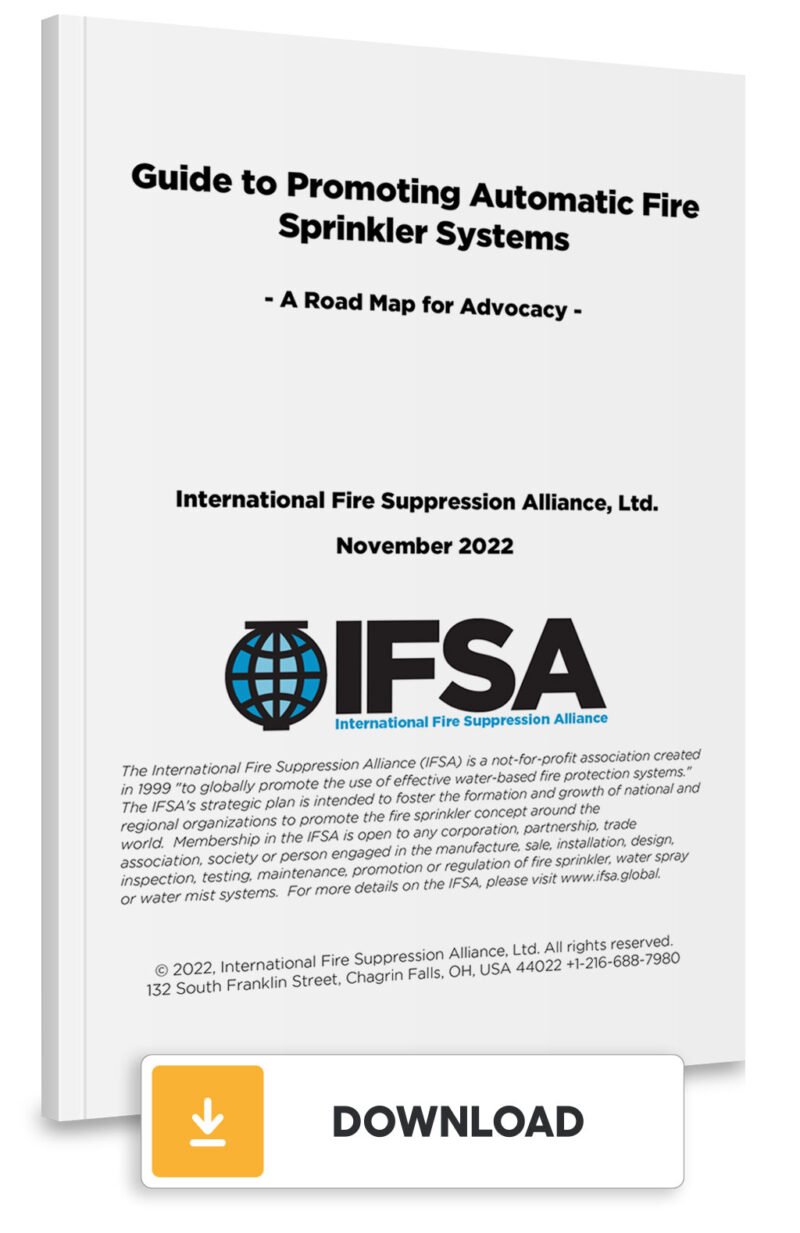Guide to Promoting Automatic Fire Sprinkler Systems: Pursuing Regulatory Changes in a Code Environment

Enter your email to download the full Guide.
There are multiple strategies to use to promote greater use of automatic fire sprinkler systems. As discussed in previous blog posts about the IFSA’s Guide to Promoting Automatic Fire Sprinkler Systems: A Road Map for Advocacy, two strategies rose to the top:
- “Convincing code writers to require sprinkler systems for specific occupancies”
- “Encouraging fire authorities to promote fire sprinklers”
Advocating for increased fire sprinkler use requires evaluating current codes, incentives and identifying areas with potential for success. In countries with established codes and other building regulations that contain enforcement provisions, it’s important to understand how their individual codes are developed and amended. Advocates must identify key influencers and the regulatory change process. A successful effort involves crafting a clear strategy, setting a proposed timeline and defining deliverables to guide the code change initiative from planning through implementation.
5 Steps to Seek Regulatory Changes
Outlining how to go about pursuing regulatory changes, here are five steps you can take and questions to address at each step.
1. Evaluate existing requirements and incentives for automatic sprinklers
- What is the current attitude toward the use of fire sprinklers in the code?
- What incentives/alternatives does the use of sprinklers provide the designer?
- How do the current requirements and incentives compare to those in other countries?
- Has recent fire experience in the country/region provided support for a code change effort favorable to the use of automatic sprinkler systems?
2. Identify the regulatory structure
- How is the code developed?
- Who controls the code development process?
- Are there any committees or key “influencers” who manage the process?
- Is there an established review cycle or timeline?
- What political drivers and motivations are available for code changes? (life safety, political decision, political pressure for development, new data, large fire events, research, cost/benefit, lobbying from construction/business organization etc.)
- Are there major government policies that will impact building codes in upcoming years?
- Is there any current thinking on the need for change within the code relative to fire safety?
- Are there any influential peer groups/agencies/associations in the country or region that can help motivate changes in the code?
- What is the current state of enforcement of the code?
-
3. Identify the organizations active in influencing the fire safety related aspects of the building code (Note: influencers can be supporters and/or detractors of fire sprinklers)
- Who are the code development influencers based on the type of organization (government, non-profit organizations, fire safety related groups, trade groups, insurance companies and associations, consultants, research bodies, corporations, industries, contractors, architects, building owner associations, fire services, etc.)?
- For each influencer, what is their mission, structure, leadership, decision makers, key people in relation to the code, important memberships, internal committees, level of activity in regulation/code development, etc.?
- For each influencer, what are their economic and political drivers, reputation, product promotion, sector control, membership, finances, etc.?
- For each influencer, are there any friction points, e.g. reducing membership, funding, reputation issues etc.?
- For each influencer, what is their position relative to the use of automatic fire sprinklers in the code (supportive, neutral or detractor)?
- Which of the influencers are potential allies within the process for code changes in favor of automatic fire sprinklers?
- Are there potential opportunities to connect and ally supporting influencers to common themes?
4. Develop a specific strategy for code changes
- Which influencers should be the focus within the process?
- What other groups should be contacted as potential allies in the code change process?
- Are there potential in-country consultants that could be retained to assist with bringing about improvements to the code (based on their knowledge, existing relationships, share of voice, position within committees and ability to build consensus)?
-
5. Agree on a schedule and expected deliverables
- Will there be a kick-off meeting for the advocacy effort involving the full advocacy team along with representatives of allies and any involved consultants?
- How often will regular updates be needed to exchange information on progress and review strategies?
- What are the key decision-making dates for those who control the code process?
- Aside from the end goal of the code changes sought, are there interim deliverables that should be scheduled and prepared (white papers, public events, press releases, etc.)?
Pursuing regulatory changes aimed at expanding the use of automatic water-based fire suppression systems requires multiple steps and aligning with the right people and groups to usher code change initiatives from planning through implementation.
To get more information about strategies to promote the greater use of automatic fire sprinkler systems, enter your email address above to download the full IFSA Guide to Promoting Automatic Fire Sprinkler Systems: A Road Map for Advocacy.
Watch for the next blog post in this series about the Guide. It highlights contents of chapter six, “Developing a Fire Code Where None Exists.”
